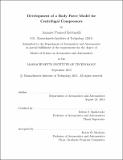Development of a body force model for centrifugal compressors
Author(s)
Kottapalli, Anjaney Pramod
DownloadFull printable version (15.89Mb)
Other Contributors
Massachusetts Institute of Technology. Department of Aeronautics and Astronautics.
Advisor
Zoltán S. Spakovszky.
Terms of use
Metadata
Show full item recordAbstract
This project is focused on modeling the internal ow in centrifugal compressors for the purpose of assessing the onset of rotating stall and surge. The current methods to determine centrifugal compressor stability limits are based on empirical data and often, experiments. Unsteady full wheel simulations have become feasible due to the increase in computation power but the prediction of the stability limit still remains a challenge. The presented methodology is based on the idea of body forces and a blade passage model suitable for centrifugal compressors is derived. Previous work has shown that blade passage models are capable of capturing the response to inlet ow distortions and the onset of instability in axial compressors. In this thesis, a blade passage model is developed for centrifugal compressors with the goal of capturing the three-dimensional through-ow computed by steady RANS simulations. The model consists of three main elements, a normal force model, a viscous parallel force model, and a blade metal blockage model. The work demonstrates the model's capabilities on a radial impeller with prismatic blades where the total-to-static pressure rise coefficient and stage loading coefficient are in agreement with RANS calculations within 6.75% and 5%, respectively. While the model denition is shown to be consistent with other blade passage models for axial compressors, its application to a transonic axial compressor rotor and a high-speed centrifugal compressor stage revealed numerical convergence problems. It is thought that the model derivation and denition are sound and that these issues are due to implementation errors. The methodology and related modeling process are investigated step by step for three-dimensional blade geometries and, where applicable, verified with direct numerical calculation. The model limitations and potential implementation error are discussed at length so as to guide future work required to complete the demonstration of this blade passage model for axial and centrifugal compressors with three-dimensional blade shapes.
Description
Thesis: S.M., Massachusetts Institute of Technology, Department of Aeronautics and Astronautics, 2013. This electronic version was submitted by the student author. The certified thesis is available in the Institute Archives and Special Collections. Cataloged from student-submitted PDF version of thesis. Includes bibliographical references (pages 167-169).
Date issued
2013Department
Massachusetts Institute of Technology. Department of Aeronautics and AstronauticsPublisher
Massachusetts Institute of Technology
Keywords
Aeronautics and Astronautics.